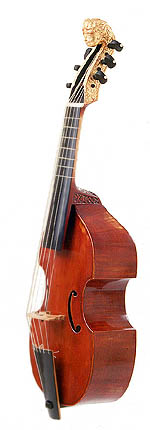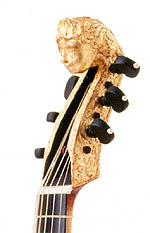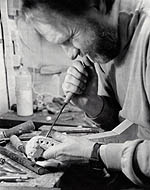|
|
 |
 eginning in the late seventeenth century in Europe, the viola
da gamba was gradually supplanted by the violoncello, whose robust sound
was better suited to the orchestras then appearing. However, the viola da
gamba continued to enjoy widespread popularity in France until the end of
the eighteenth century, during which the pardessus de viole, which
is even smaller than the treble viol, was added to the viol family. eginning in the late seventeenth century in Europe, the viola
da gamba was gradually supplanted by the violoncello, whose robust sound
was better suited to the orchestras then appearing. However, the viola da
gamba continued to enjoy widespread popularity in France until the end of
the eighteenth century, during which the pardessus de viole, which
is even smaller than the treble viol, was added to the viol family.
| |

 Pardessus de viole
Pardessus de viole
In the manner of Nicolas Bertrand
By
Dominik Zuchowicz
Ottawa, Ontario
1991
British Columbia maple and Sitka, spruce, Gabon ebony, boxwood, bone, gut, silver, gold leaf, linen and glue, oil varnish
Overall length: 63 cm; body: 31 x 18.6 cm; ribs: 7.6 cm
Label: "Dominik Zuchowicz Ottawa 20/12/91 1991" |
The French nobility adopted the instrument enthusiastically. Ladies of the
court were delighted with the pardessus de viole, whose small size made it
charming and entirely in keeping with the elegance of the era. Moreover,
the register of the pardessus enabled it to replace the violin, which women
avoided playing as it left unsightly marks on the neck.
| |

 This beautiful carved head covered with gold leaf calls to mind the
sumptuous furnishings that baroque musical instruments were designed
to complement.
This beautiful carved head covered with gold leaf calls to mind the
sumptuous furnishings that baroque musical instruments were designed
to complement.
|
Dominik Zuchowicz based this pardessus de viole on an instrument
in the Musée du Conservatoire de Paris, itself the
work of Nicolas Bertrand (d. 1725), one of the great French luthiers
of the period and the "faiseur d'instruments ordinaire de
la muzique du Roy" (The New Grove Dictionary of Musical
Instruments). A sculpted woman's head, covered with gold leaf, graces
the neck of this meticulously crafted instrument.
Dominik Zuchowicz

 Dominik Zuchowicz,
Dominik Zuchowicz,
in his Ottawa workshop, 1991.
In his Ottawa workshop, Dominik Zuchowicz builds and restores instruments
from the viol and violin family, such as the early double bass (or
violone) and the baroque violin. This artisan began his
career as an independent luthier in 1974 after spending four years repairing
and restoring instruments in a stringed-instrument workshop in Winnipeg.
At first, he focused mainly on instrument repair, but began making more and
more instruments, specializing in early models. With the help of a Canada
Council grant in 1981, he undertook research in European collections and
at the Boston Museum of Fine Arts. While in the United States, he acted as
restoration consultant for the Boston Symphony Orchestra's Casedessus
collection and for the collection of the period music division of the New
England Conservatory of Music in Boston. At the same time, he developed a
clientele of musicians with a keen interest in period music.
In 1982, Dominik Zuchowicz returned to Ottawa. His clients include
numerous professionals, and his instruments are played in the faculties of
music of the Université de Montreal,
McGill University, Carleton University, and the University of Western
Ontario.
| |

Dominik Zuchowicz's label
|
|







